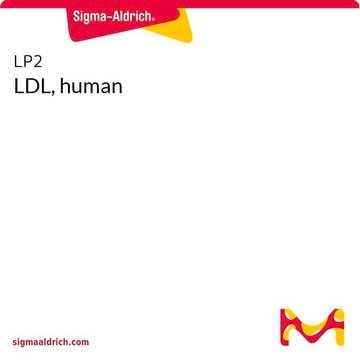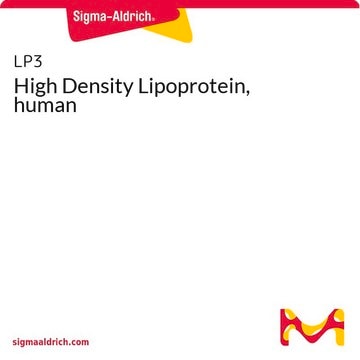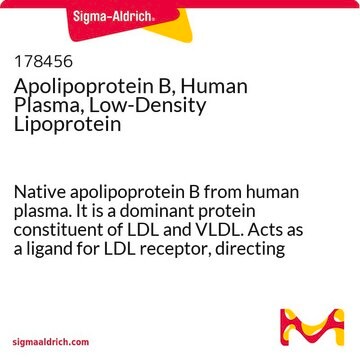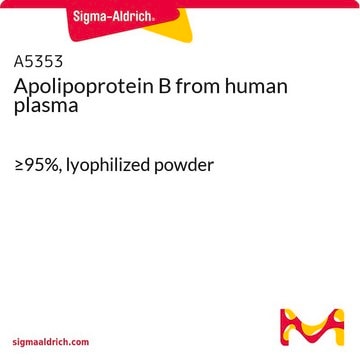L8292
Lipoprotein, low density from human plasma
lyophilized powder
Synonym(s):
β-Lipoprotein, LDL, Low density lipoprotein
Sign Into View Organizational & Contract Pricing
All Photos(3)
About This Item
Recommended Products
biological source
human plasma
form
lyophilized powder
packaging
vial of ~5 mg protein
technique(s)
cell culture | stem cell: suitable
UniProt accession no.
storage temp.
2-8°C
Gene Information
human ... APOA1(335)
Looking for similar products? Visit Product Comparison Guide
General description
Lipoprotein, low density (LDL) is synthesized by lipolysis and lipid transfer steps. They are formed from very low-density lipoprotein (VLDL) after uptake by LDL receptor in hepatocytes. LDL normal level of 130 mg/dL is desirable in human plasma. It is referred as bad cholesterol.
Application
Lipoprotein was used to study effect of the surface density of nano-segments immobilized on culture dishes on ex vivo expansion of hematopoietic stem and progenitor cells from umbilical cord blood. It was also used in the separation and cultivation of hematopoietic stem cells from umbilical cord blood by permeation through membranes with nano-segments.
Lipoprotein, low density from human plasma has been used:
- in evaluating its anti-Langerhans cells (LC) differentiation activity in monocyte-derived Langerhans cells (MDLCs)
- in the preparation of oxidized low-density lipoprotein (ox-LDL)
- as a lipoprotein standard in quantifying embryonic cerebrospinal fluid (eCSF) from HH23 embryos by lipid staining
Biochem/physiol Actions
LDL and HDL transport both dietary and endogenous cholesterol in the plasma. LDL is the main transporter of cholesterol and cholesteryl esters and makes up more than half of the total lipoprotein in plasma. LDL is absorbed by the liver and other tissues via receptor mediated endocytosis. The cytoplasmic domain of the LDL receptor facilitates the formation of coated pits; receptor-rich regions of the membrane. The ligand binding domain of the receptor recognizes apo-B100 on LDL, resulting in the formation of a clathrin-coated vesicle. ATP-dependent proton pumps lower the pH inside the vesicle resulting dissociation of LDL from its receptor. After loss of the clathrin coat the vesicles fuse with lysozomes, resulting in peptide and cholesteryl ester enzymatic hydrolysis. The LDL receptor can be recycled to the cell membrane. Insulin, tri-iodothyronine and dexamethasome have shown to be involved with the regulation of LDL receptor mediated uptake.
The apolipoprotein component of the LDL particle interacts with extracellular matrix in arterial intima resulting in their retention. LDL is the major driver of atherosclerotic cardiovascular disease progression.
Physical properties
Low density lipoproteins are smaller than VLDL and IDL (26 nm) (MW approximately 3.5 million) and more dense (~1.04). The protein component of LDL is apolipoprotein B100. LDL contains 20-22% protein, 10-15% triglycerides, 20-28% phospholipids, 37-48% cholesteryl esters and 8-10% cholesterol.
Preparation Note
Lyophilized from a solution of 0.15 M NaCl and 0.01% EDTA, pH 7.4
Disclaimer
RESEARCH USE ONLY. This product is regulated in France when intended to be used for scientific purposes, including for import and export activities (Article L 1211-1 paragraph 2 of the Public Health Code). The purchaser (i.e. enduser) is required to obtain an import authorization from the France Ministry of Research referred in the Article L1245-5-1 II. of Public Health Code. By ordering this product, you are confirming that you have obtained the proper import authorization.
Storage Class Code
11 - Combustible Solids
WGK
WGK 3
Flash Point(F)
Not applicable
Flash Point(C)
Not applicable
Personal Protective Equipment
dust mask type N95 (US), Eyeshields, Gloves
Certificates of Analysis (COA)
Search for Certificates of Analysis (COA) by entering the products Lot/Batch Number. Lot and Batch Numbers can be found on a product’s label following the words ‘Lot’ or ‘Batch’.
Already Own This Product?
Find documentation for the products that you have recently purchased in the Document Library.
Customers Also Viewed
Gaëlle Picarda et al.
Journal of immunology (Baltimore, Md. : 1950), 196(9), 3716-3728 (2016-03-27)
Langerhans cells (LCs) are epithelial APCs that sense danger signals and in turn trigger specific immune responses. In steady-state, they participate in the maintenance of peripheral tolerance to self-antigens whereas under inflammation LCs efficiently trigger immune responses in secondary lymphoid
Interaction between SCO-spondin and low density lipoproteins from embryonic cerebrospinal fluid modulates their roles in early neurogenesis
Vera A, et al.
Frontiers in Neuroanatomy, 9, 72-72 (2015)
Vitamin A decreases cytotoxicity of oxidized low-density lipoprotein in patients with atherosclerosis
Mahmoudi MJ, et al.
Immunological Investigations, 45(1), 52-62 (2016)
Separation and Cultivation of Hematopoietic Stem Cells from Umbilical Cord Blood by Permeation through Membranes with Nano-Segments
Higuchi, Akon; Chen, Li-Ying; Shiao, Jui-Shiang; Ling, Qing-Dong; Ko
Current Science, 7, 908-914 (2011)
Mohammad Jafar Mahmoudi et al.
Immunological investigations, 45(1), 52-62 (2015-12-25)
Oxidized low-density lipoprotein (ox-LDL) is implicated in initiation and progression of atherosclerosis. Previously, we found that ox-LDL increases vulnerability of peripheral blood mononuclear cells (PBMCs) in atherosclerotic patients compared to controls. Vitamin A induces proliferation of PBMCs. The aim of
Our team of scientists has experience in all areas of research including Life Science, Material Science, Chemical Synthesis, Chromatography, Analytical and many others.
Contact Technical Service